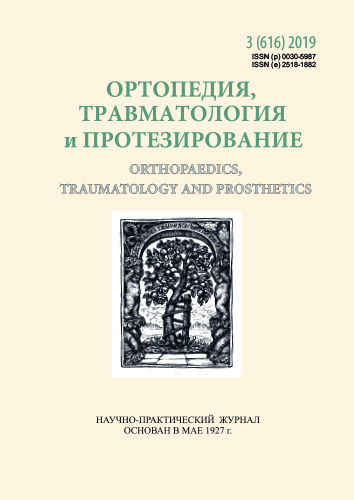Antibacterial properties of a modified magnesium alloy with clinical strains of non-fermentative gram-negative microorganisms in vitro
DOI:
https://doi.org/10.15674/0030-59872019360-63Keywords:
magnesium alloy, implant, antibacterial properties, Acinetobacter baumannii, Pseudomonas aeruginosaAbstract
The objective is to determine the sensitivity of A. baumannii and P. aeruginosa (etiological agents of implant-associated infections) to the ML-10 magnesium alloy biodegradation products to justify the possibility of its application in traumatological practice as implants with antibacterial activity.
Methods: ML10 magnesium alloy extract was made based on Mueller–Hinton broth (pH 7.4). Its bacteriostatic activity was assessed by the presence/absence of visual growth of A. baumannii and P. aeruginosa in culture tubes, and the bactericidal activity — by the presence/absence of growth of microorganism colonies on agar plates after plating from the tubes after 24, 28, and 72 h of incubation.
Results: the extract of alloy ML-10 magnesium alloy has a high bacteriostatic and bactericidal activity in relation to the clinical strains of A. baumannii and P. aeruginosa. No growth of microorganisms was visually detected in test tubes with extract, which indicated a significant bacteriostatic activity of the alloy biodegradation products. In the study of bactericidal activity, the maximum growth of bacteria on agar was observed after the first seeding from tubes (24 hours of incubation of the extract) into which microorganisms were added the day before at a concentration of 109 , 108 , 107 CFU/ml. The number of colonies grown on agar after the second seeding (48 hours of incubation of the extract) was significantly reduced, and after the third seeding (72 hours), the growth of microorganisms was absent in most of experiments. In the case of the addition of microorganisms at a concentration of 106 , 105 , 104 CFU/ml, there was no colony growth on a solid medium after seeding from these tubes.
Conclusions: ML-10 magnesium alloy biodegradation products exhibit high bactericidal activity against clinical strains of A. baumannii and P. aeruginosa, which are the causative agents of implant-associated infections.
References
- Thakore, R. V., Greenberg, S. E., Shi, H., Foxx, A. M., Francois, E. L., Prablek, M. A., & Sethi, M. K. (2015). Surgical site infection in orthopedic trauma: A case–control study evaluating risk factors and cost. Journal of Clinical Orthopaedics and Trauma, 6 (4), 220–226. doi:10.1016/j.jcot.2015.04.004
- Scheffer, D., Hofmann, S., Pietsch, M., & Wenisch, C. (2008). Infektionen in der Orthopädie und Traumatologie. Der Orthopäde, 37(7), 709-720. doi:10.1007/s00132-008-1301-x (in German)
- Busscher, H. J., Van der Mei, H. C., Subbiahdoss, G., Jutte, P. C., Van den Dungen, J. J., Zaat, S. A., & Grainger, D. W. (2012). Biomaterial-associated infection: locating the finish line in the race for the surface. Science Translational Medicine, 4 (153), 153rv10–153rv10. doi:10.1126/scitranslmed.3004528
- Al-Mulhim, F. A., Baragbah, M. A., Sadat-Ali, M., Alomran, A. S., & Azam, M. Q. (2014). Prevalence of surgical site infection in orthopedic surgery: a 5-year analysis. International Surgery, 99 (3), 264–268. doi:10.9738/intsurg-d-13-00251.1
- Martínez-Pastor, J. C., Munoz-Mahamud, E., Vilchez, F., Garcia-Ramiro, S., Bori, G., & Sierra, J, et al. (2009) Outcome of acute prosthetic joint infections due to gram-negative bacilli treated with open debridement and retention of the prosthesis. Antimicrobial agents and Chemotherapy, 53 (11), 4772–4777. doi: 10.1128/AAC.00188-09.
- Brady, R. A., Calhoun, J. H., Leid, J. G., & Shirtliff, M. E. (n.d.). Infections of orthopaedic implants and devices. Springer Series on Biofilms, 15–55. doi:10.1007/978-3-540-68119-9_2
- Stewart, P. S., & William Costerton, J. (2001). Antibiotic resistance of bacteria in biofilms. The Lancet, 358 (9276), 135–138. doi:10.1016/s0140-6736(01)05321-1
- He, G., Wu, Y., Zhang, Y., Zhu, Y., Liu, Y., Li, N., & Mao, C. (2015). Addition of Zn to the ternary Mg-Ca-Sr alloys significantly improves their antibacterial properties. Journal of Materials Chemistry B, 3 (32), 6676–6689. doi:10.1039/c5tb01319d
- Robinson, D. A., Griffith, R. W., Shechtman, D., Evans, R. B., & Conzemius, M. G. (2010). In vitro antibacterial properties of magnesium metal against Escherichia coli, Pseudomonas aeruginosa and Staphylococcus aureus. Acta Biomaterialia, 6 (5), 1869–1877. doi:10.1016/j.actbio.2009.10.007
Downloads
How to Cite
Issue
Section
License
Copyright (c) 2019 Vadim Chornіy

This work is licensed under a Creative Commons Attribution 4.0 International License.
The authors retain the right of authorship of their manuscript and pass the journal the right of the first publication of this article, which automatically become available from the date of publication under the terms of Creative Commons Attribution License, which allows others to freely distribute the published manuscript with mandatory linking to authors of the original research and the first publication of this one in this journal.
Authors have the right to enter into a separate supplemental agreement on the additional non-exclusive distribution of manuscript in the form in which it was published by the journal (i.e. to put work in electronic storage of an institution or publish as a part of the book) while maintaining the reference to the first publication of the manuscript in this journal.
The editorial policy of the journal allows authors and encourages manuscript accommodation online (i.e. in storage of an institution or on the personal websites) as before submission of the manuscript to the editorial office, and during its editorial processing because it contributes to productive scientific discussion and positively affects the efficiency and dynamics of the published manuscript citation (see The Effect of Open Access).














